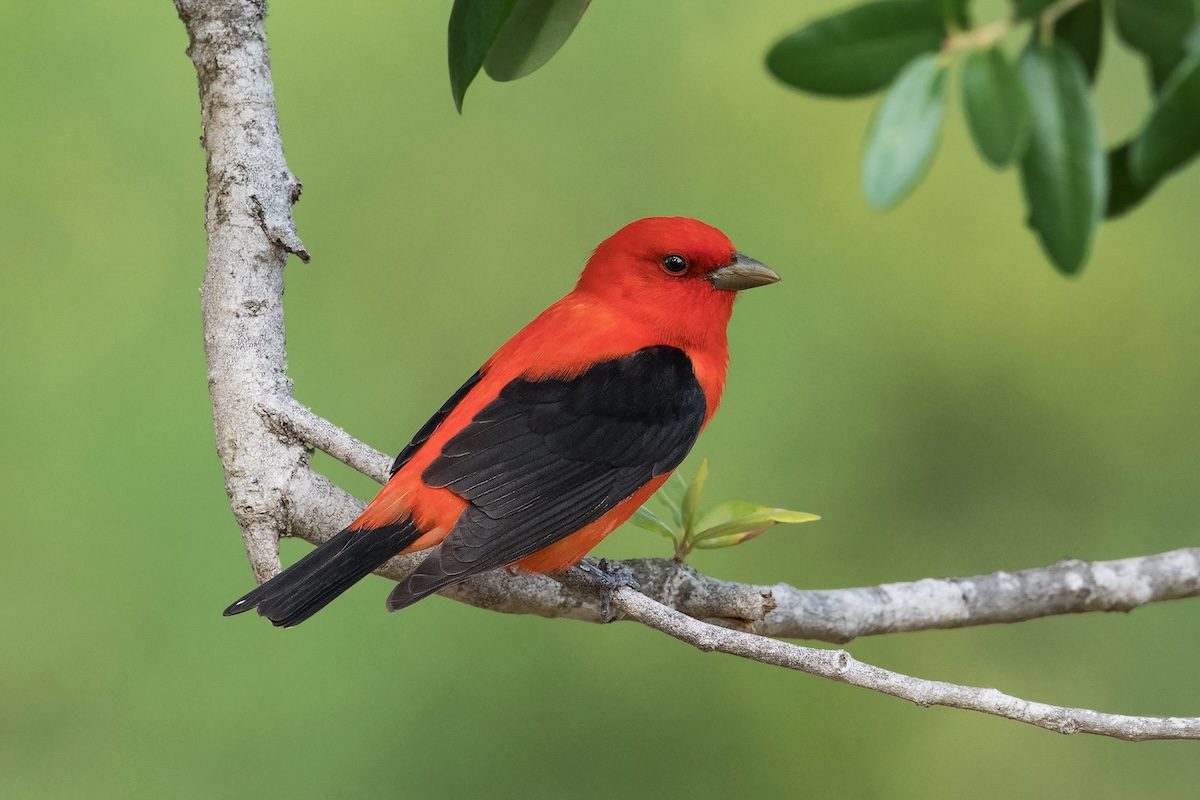Look for a bright red male scarlet tanager in spring and summer. Learn about this songbird's nest, range map, song and more.

How to Identify a Scarlet Tanager

On This Page
What Does a Scarlet Tanager Look Like?

The scarlet tanager is a medium-sized songbird, 7 inches long with a wingspan of 11-1/2 inches. The male is unmistakable in summer—bright red with black wings and tail until fall.
Before migrating south, males perform a costume change, molting their red feathers and replacing them with yellow-green tones like those of the female. Males go through another molt in late winter before heading north, so when they reach the eastern woods, they have the brilliant colors you know and love.
Female Scarlet Tanager

The female scarlet tanager is more subtly colored, sporting soft yellow-green plumage with darker olive green wings and tail. It makes sense for her to be camouflaged, because she builds the nest and incubates the eggs. However, the male does step up to help feed the young.
Check out the vibrant tanager bird species you should know.
Juvenile Scarlet Tanager
Young birds are dull greenish-yellow like the females. One of the best ID clues is the shape of the bill—thick at the base, with a curved outline.
Western tanagers are fiery, eye-catching fliers.
Scarlet Tanager Molting

“Is this scarlet tanager’s interesting plumage (above) because of age or a seasonal thing?” asks Birds & Blooms reader Nancy Tully.
Birding experts Kenn and Kimberly Kaufman explain, “The male scarlet tanager changes color twice a year by molting its feathers in early spring and early fall. It’s mostly olive green in winter and bright red in summer. During the process of molting, it shows irregular patches of both colors, as does the bird in your photo.
Males in their first summer can look more orange-red, with some olive body feathers and brown in the wings. But they’re not likely to sport this half-and-half appearance, so the bird in this photo shows the effect of the season, not its age.”
Learn how to identify a summer tanager.
Scarlet Tanager Song
The male scarlet tanager generally arrives earlier than the female, but the female won’t come looking for him until he has established a territory in the forest. Once he has this turf, he’ll sing from the treetops to attract a female and to warn other males to stay off his territory.
Scarlets announce their annual arrival with a hoarse, whistled song. They sing phrases in a rapid pattern, similar to an American robin with a sore throat. They also make a short call, “chik-burr.”
Listen to the scarlet tanager’s song.
Bird songs provided by the Cornell Lab of Ornithology.
What Do Scarlet Tanagers Eat?

Scarlet tanagers use their fairly thick bills to eat mostly insects, and also some berries. Tanagers don’t flock to oranges the way orioles do. But when the first males return from the tropics in early spring, they may have trouble finding insects to eat, so they’re more likely to try different things.
They occasionally visit backyards for sugar water, suet, mealworms and grape jelly. You may entice them with other fruits like bananas or sliced watermelon.
And provide a water source, especially a birdbath with a dripper or a small fountain that creates the sound of trickling water.
Scarlet Tanager Nest
These birds are choosy about nesting sites, so they won’t stay around for summer unless you live close to forest land. The female builds a shallow, saucer-shaped nest, usually high in an oak tree, and lays two to five light speckled eggs.
Scarlet Tanager Range and Habitat

This species tends to stay high in treetops in deciduous forest canopies. Throughout summer, scarlet tanagers are widespread in the eastern states and southeastern Canada, mainly in forests dominated by oaks. They spend winters in lowland rain forest areas of the Amazon basin in South America. Passing migrants can show up almost anywhere.

Range maps provided by Kaufman Field Guides, the official field guide of Birds & Blooms.
Next, learn where to find flame-colored and hepatic tanagers.




















